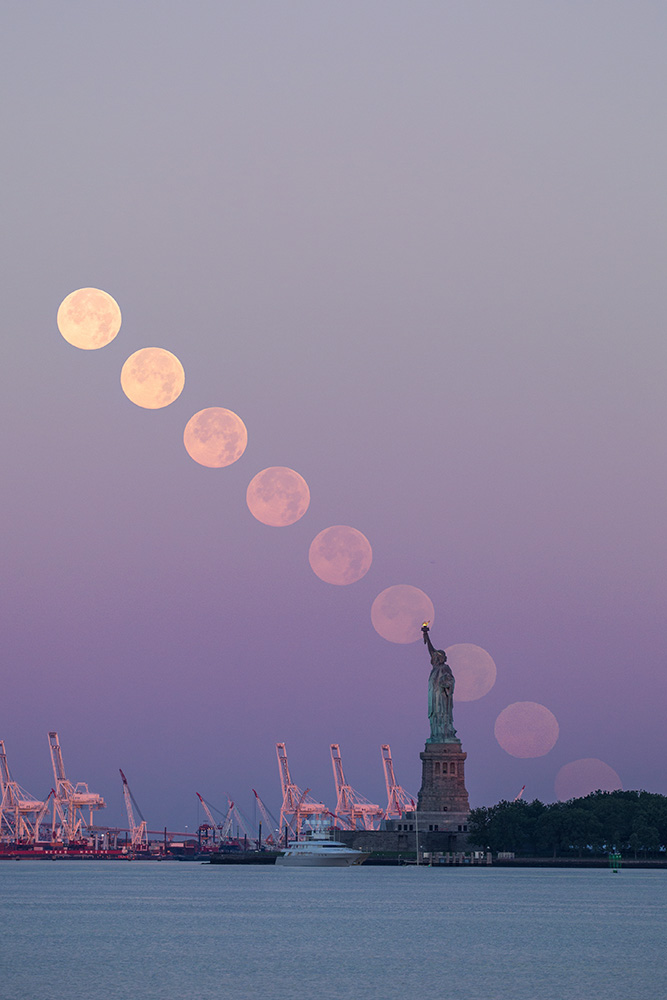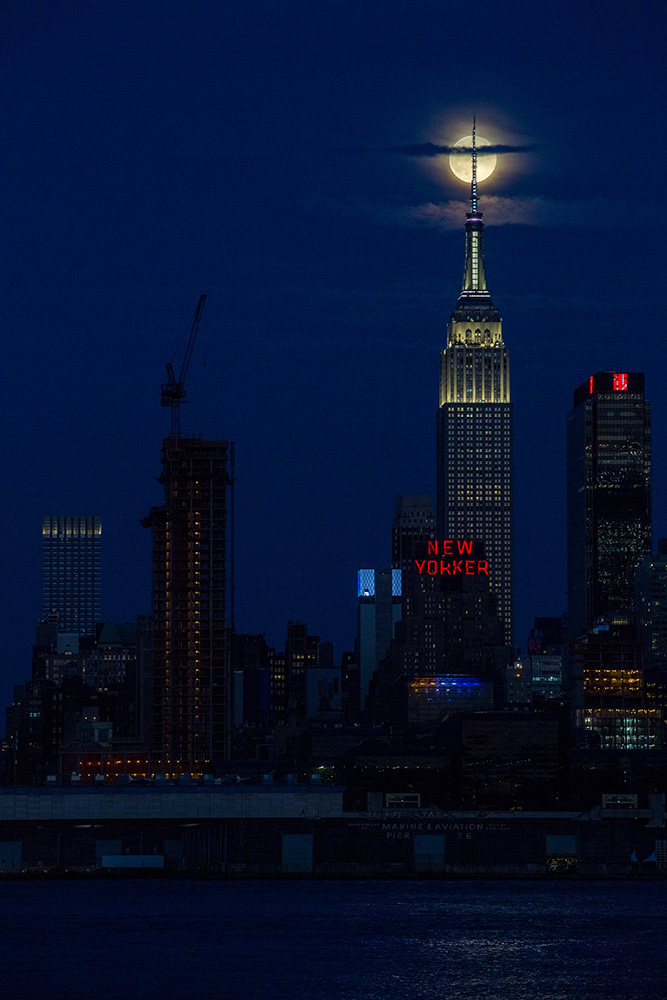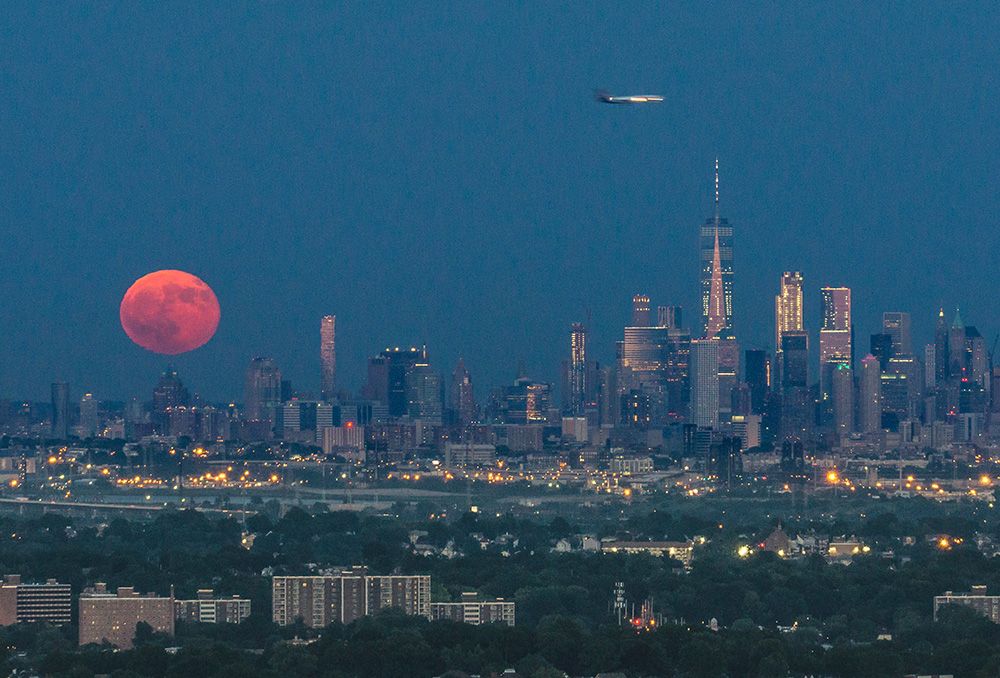Full 'Thunder Moon' Meets Stormy Skies in Awesome Night Sky Photos
Both the full Thunder Moon and a few flashes of lightning shone in the skies across the U.S. this weekend as astrophotographers captured stunning views of the cloud-shrouded orb.
The Thunder Moon, or the full moon in July, gets its name from the inclement weather that is so common in the Northern Hemisphere this time of year. Sticking true to its name, this year's Thunder Moon brought lightning and thunderclouds to parts of the U.S., though other skywatchers were treated to clear skies. [Moon Photography Tips from Astrophotographers: A Visual Guide]
While the full moon peaked just after midnight on Sunday (July 9) at 12:07 a.m. EDT (0407 GMT), it appeared pretty much full one day before and after this peak. So, photographers who encountered too many clouds to capture the full moon at its fullest still had chance to postpone their late-night lunar photo shoots until a time with clearer skies. [Moon Photography Tips from Astrophotographers: A Visual Guide]
Despite some lightning over Murrells Inlet in South Carolina, Austin Bond captured clear images of the full moon rising there on Saturday evening (July 8). He set up his camera at Belin Memorial United Methodist Church and filmed a short video of lightning strikes behind the Thunder Moon.
In one of the photos Bond captured of that night, the moon appears to be perching atop a wooden cross. "I typically go watch the full moon rise at the cross by the inlet seawall," Bond told Space.com in an email. "Usually, others are watching the moon rise, but for some reason no one was out there last night, so I decided to include the cross in the photo as this was a rare time that people were not standing around it."
One New York City photographer, Gowrishankhar L., set out to photograph the full Thunder Moon over the cityscape on Saturday night and was met by dense cloud coverage. "I took some shots of the moonrise on Saturday evening from Weehawken, New Jersey … [but] since it was cloudy, I decided to also capture the moonset over the Statue of Liberty from Battery Park [in New York] on Sunday early morning," Gowrishankhar told Space.com in an email.
Despite the cloud coverage, Gowrishankhar managed to capture an incredible shot of the full moon skewered on the top of the Empire State Building.
Breaking space news, the latest updates on rocket launches, skywatching events and more!
Another photographer in the New York City area, Chirag Upreti, waited for clearer skies to take his photo of the nearly full moon on Sunday evening. As he photographed the moon at dusk, Upreti also captured an airplane flying over the World Trade Center.
"The moon rises over the Manhattan skyline with a beautiful red-orange hue as twilight reflects off the monolithic glass structure of One World Trade [Center]," Upreti told Space.com in an email. "We also see the pronounced effects of atmospheric optics when viewing low-lying subjects over the horizon: The bottom left region of the moon is wavy! Or, perhaps more simply, the Thunder Moon was in a groovy state of mind," he joked.
In St. Louis, photographer Pradip Patel was blessed with perfectly clear skies. He shot the full, glowing moon from beneath the St. Louis Arch. "I wanted to capture the full arch with the moon but was in a pinch for time and had to compromise the full arch for a larger moon," Patel told Space.com in an email. He took his photo just a few minutes after sunset on Saturday.
Editor's Note: If you capture an amazing night-sky photo and want to share it with Space.com for a story or gallery, please send images and comments to managing editor Tariq Malik at spacephotos@space.com.
Email Hanneke Weitering at hweitering@space.com or follow her @hannekescience. Follow us @Spacedotcom, Facebook and Google+. Original article on Space.com.

Hanneke Weitering is a multimedia journalist in the Pacific Northwest reporting on the future of aviation at FutureFlight.aero and Aviation International News and was previously the Editor for Spaceflight and Astronomy news here at Space.com. As an editor with over 10 years of experience in science journalism she has previously written for Scholastic Classroom Magazines, MedPage Today and The Joint Institute for Computational Sciences at Oak Ridge National Laboratory. After studying physics at the University of Tennessee in her hometown of Knoxville, she earned her graduate degree in Science, Health and Environmental Reporting (SHERP) from New York University. Hanneke joined the Space.com team in 2016 as a staff writer and producer, covering topics including spaceflight and astronomy. She currently lives in Seattle, home of the Space Needle, with her cat and two snakes. In her spare time, Hanneke enjoys exploring the Rocky Mountains, basking in nature and looking for dark skies to gaze at the cosmos.
![Lightning flashes behind the full Thunder Moon in this video clip filmed by Austin Bond at the Belin Memorial United Methodist Church in Murrells Inlet, South Carolina. [Watch the full video]](https://cdn.mos.cms.futurecdn.net/wCSJNTDkzqZTiasrwRqpCL.gif)





